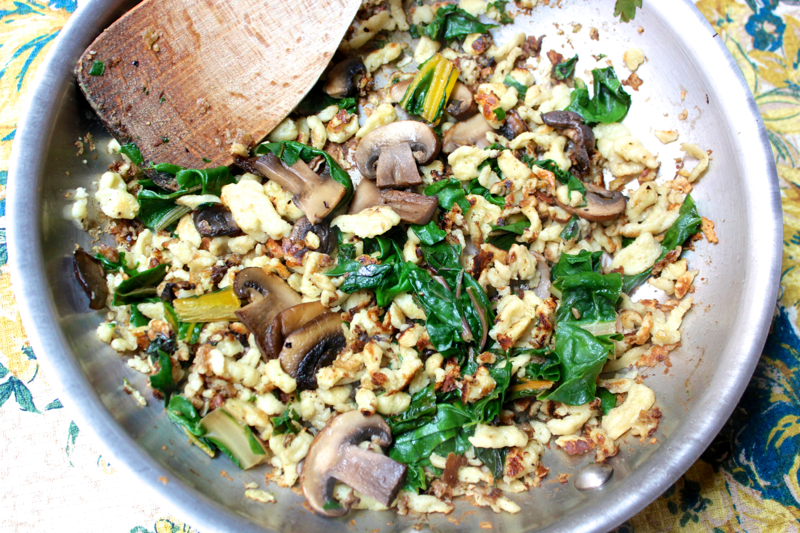
I have wanted to make spaetzle for quite some time, and I am glad that I finally did. It was fun! Spaetzle is a German/Austrian egg noodle/dumpling that is twisty and rustic. Once made, there are a lot of ways to eat spaetzle. My favorite is crisped up in a pan, but you can also toss it with butter or oil, or bake it into a cheesy, macaroni-like tangle. It took some experimenting in the kitchen to figure out the best way to form the spaetzle before dropping them into boiling water to cook. Although dedicated spaetzle makers are available, I had fantastic luck re-purposing a kitchen accessory that I already owned. I’m sure you can find something that will work for you too!
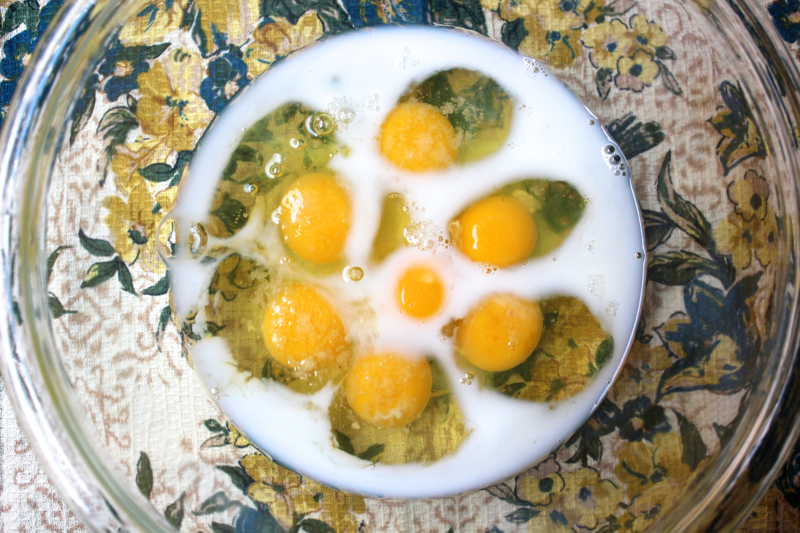
To make the spaetzle batter, whisk together 7 large eggs with 1/4 cup of milk and 1.25 teaspoons of fine sea salt. Then, stir in 2 cups of flour until most of the lumps are eliminated. The quantities specified in this recipe make a lot of spaetzle. I’d estimate around 12 side servings or 6 main course servings, maybe even more. You could halve the recipe and make less or freeze any extra for a later use. How do you halve a recipe that calls for 7 eggs, you ask? I would whisk the odd egg on its own very well and then pour half of it off.
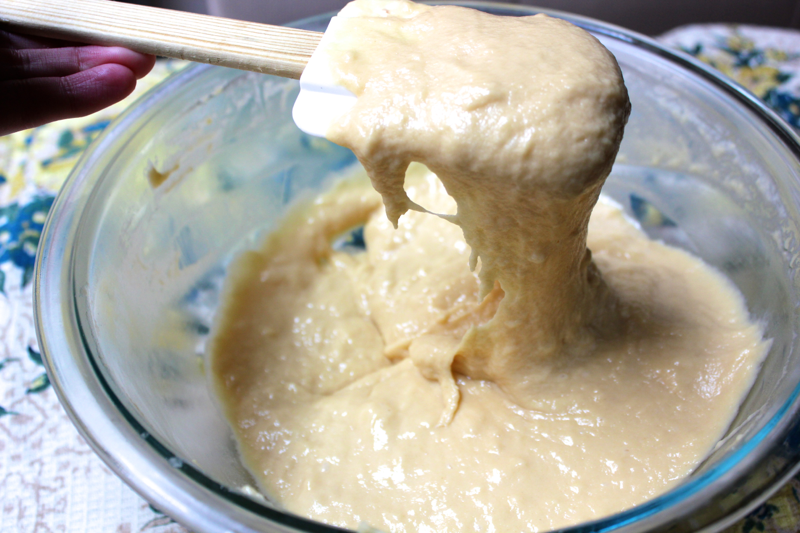
Once the batter is combined, cover it with plastic wrap, and transfer it to the refrigerator to rest for 1 hour. The resting time allows the batter to develop gluten, which contributes to the batter’s smooth, stretchy consistency. While the batter chills, bring a large pot of salted water to a simmer. Also, fill a large bowl with ice water.
To form the spaetzle, you’ll need to use a silicone spatula to press the batter through an item with holes and allow the batter to drop into the pot of simmering water. I first tried using a metal steamer/straining basket, which I set on top of the pot. It didn’t work because the strainer prevented the hot steam from leaving the pot, and the built-up heat cooked the batter before I could press it through the holes. My next attempt was much more successful- I used the plastic strainer top that came with my fat separator. It’s nice because it has a tongue-type handle that allowed me to hold it over the pot easily.
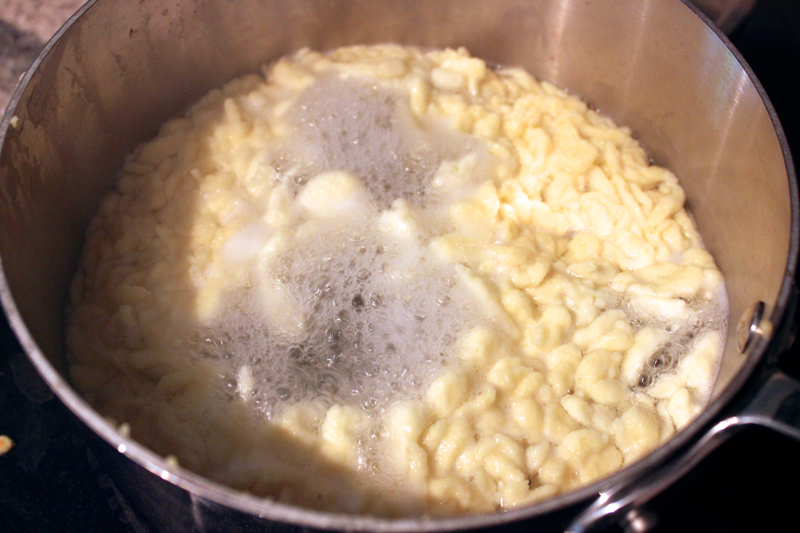
Once you find something that works for you, dollop some of the batter onto it, and use a spatula to press the batter through the holes. The batter will form raindrops that land in the water, sink, and then float to the top. The spaetzle expand and turn opaque as they cook, which takes about 1 minute. When the batch is done, use a skimmer to remove it from the pot, and transfer the spaetzle into the bowl of ice water. Repeat until you’ve cooked all of the batter.

Drain the cooked spaetzle from the ice water. You can store it in containers in the refrigerator for up to a week. 12 servings of spaetzle is a whole lot, so I came up with several different ways to serve it.
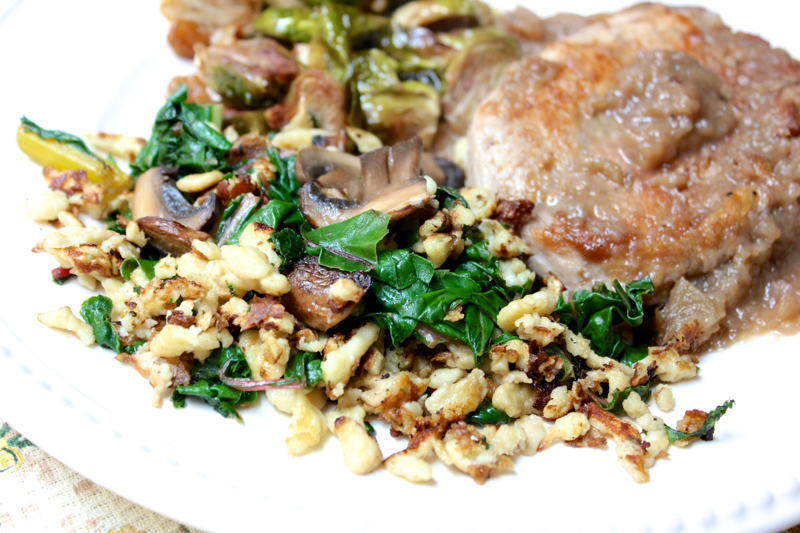
- Pan fried: Add 1 sliced shallot and some swiss chard leaves to a large, lightly oiled pan. Pour in about 1/4 cup of white wine, and let it cook off. Season the veggies with salt and pepper, melt in 2 tablespoons of butter, and add in 1-2 cups of the spaetzle. Fry it until it browns and turns crisp. The spaetzle picks up the best color and flavor in a stainless skillet, but it tends to stick. A fish spatula is really helpful to scrape and turn it. Alternatively, the spaetzle glides easily in a non-stick skillet, but the flavor isn’t as deep. Zest 1/2 lemon over the spaetzle. Grated gruyere cheese is also nice. To make it more of a meal, you can also add some diced, pre-cooked chicken when you add the spaetzle.
- Baked with cheese: You can make mac and cheese with spaetzle instead of pasta. Melt 3 tablespoons of butter in pot, stir in 3 tablespoons of flour, and then pour in 1 cup of milk. Season the milk with salt and cayenne pepper. Stir the milk until it thickens, remove the pot from heat, and melt in 1 cup of grated cheese (gruyere and cheddar are nice). Stir in about 2 cups of spaetzle and optional meal-enhancers: chicken, bacon, swiss chard, mushrooms, parmesan cheese, etc. Transfer the spaetzle and cheese to a greased baking dish, top it with more grated cheese, and bake it at 400º F until the top is golden brown.
How do you like to serve spaetzle? I need more techniques so I can finish eating my way through this big batch!
This recipe is adapted from Smitten Kitchen.
Shopping list:
- Eggs- 7
- Milk- 1/4 cup
- Sea salt, fine- 1.25 teaspoons
- Flour- 2 cups

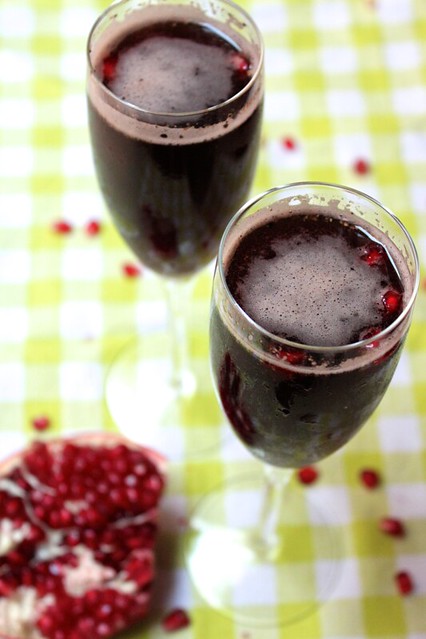
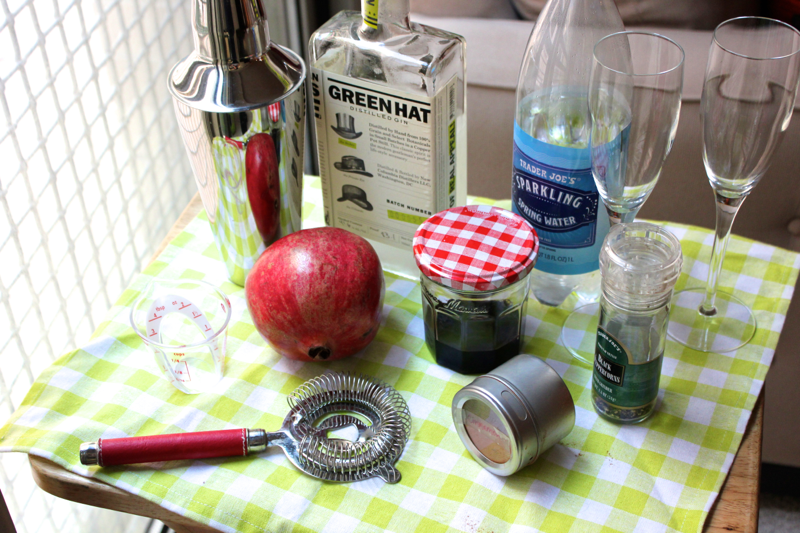





 Then, turn the roller to setting number 2, or the next thickest setting. Pass the folded pasta through, with the long side of the pasta rectangle going in first. Without folding the dough again, continue decreasing the roller settings, passing the pasta through once, until you reach setting number 8, or the thinnest setting. If the pasta gets too long to manage during this process, you can use a sharp knife to cut it into sections on a piece of parchment paper to avoid sticking. Just remember which setting the pasta was on when you cut it so you can continue rolling where you left off.
Then, turn the roller to setting number 2, or the next thickest setting. Pass the folded pasta through, with the long side of the pasta rectangle going in first. Without folding the dough again, continue decreasing the roller settings, passing the pasta through once, until you reach setting number 8, or the thinnest setting. If the pasta gets too long to manage during this process, you can use a sharp knife to cut it into sections on a piece of parchment paper to avoid sticking. Just remember which setting the pasta was on when you cut it so you can continue rolling where you left off.


